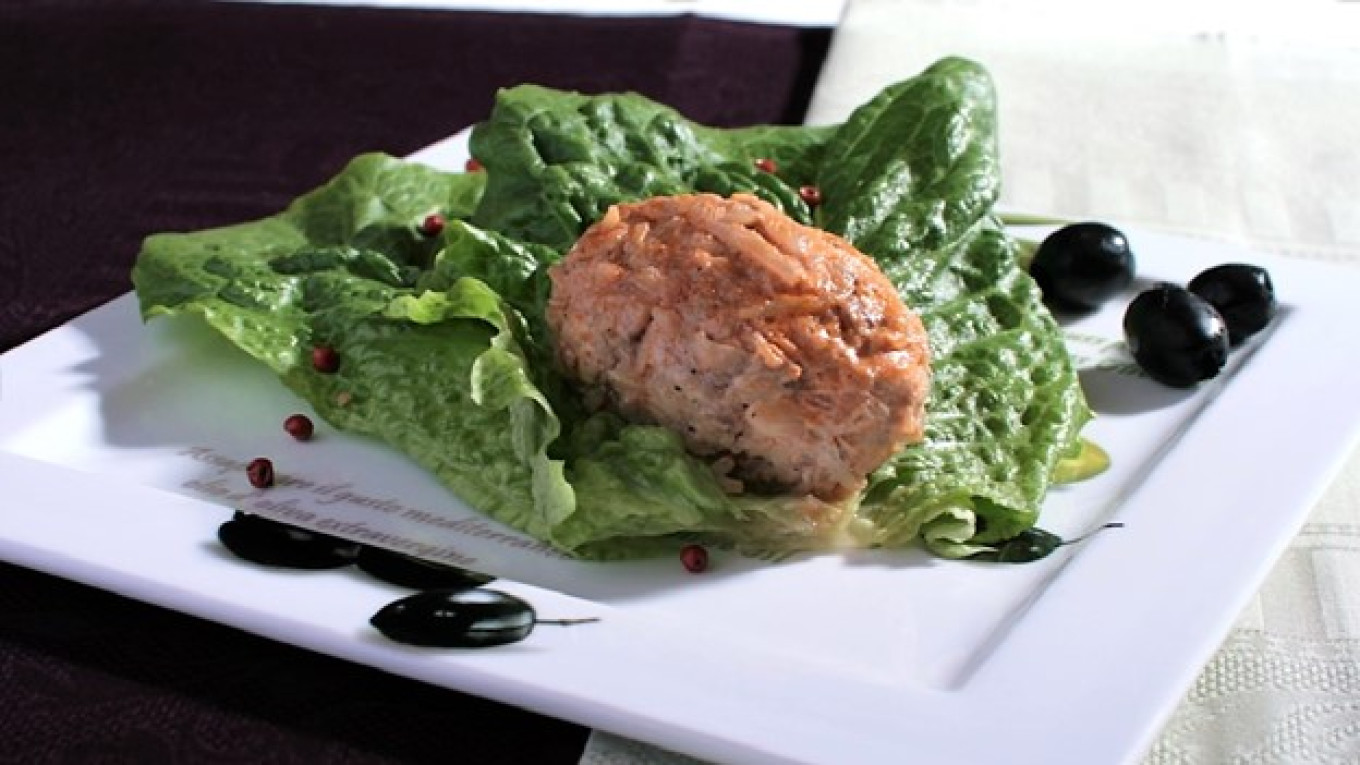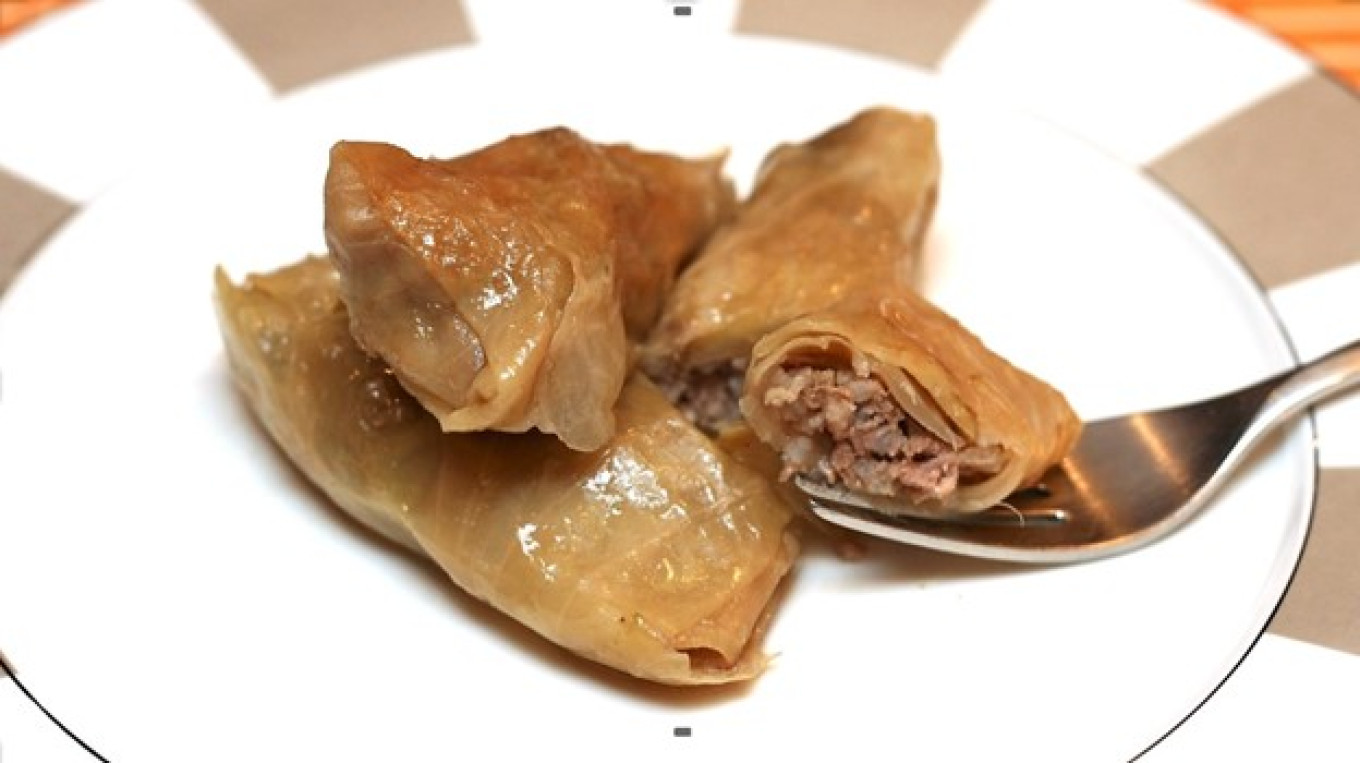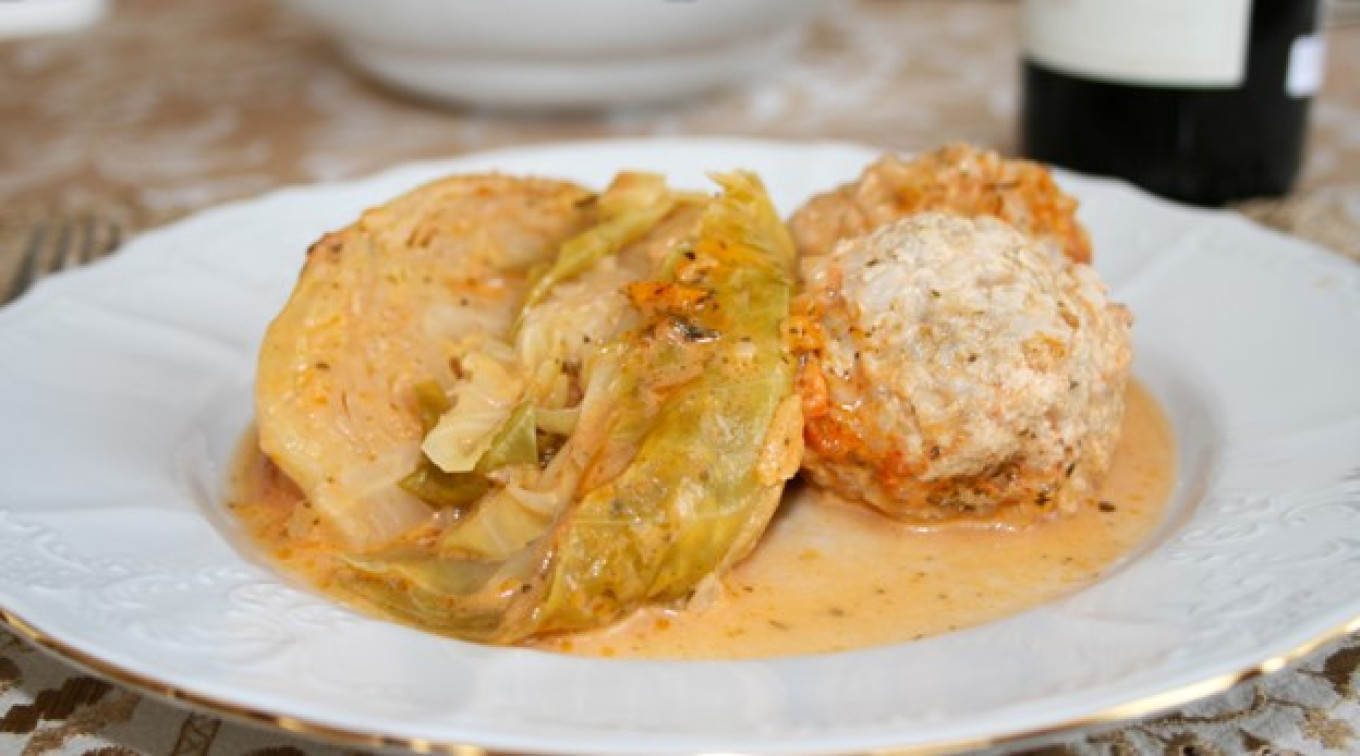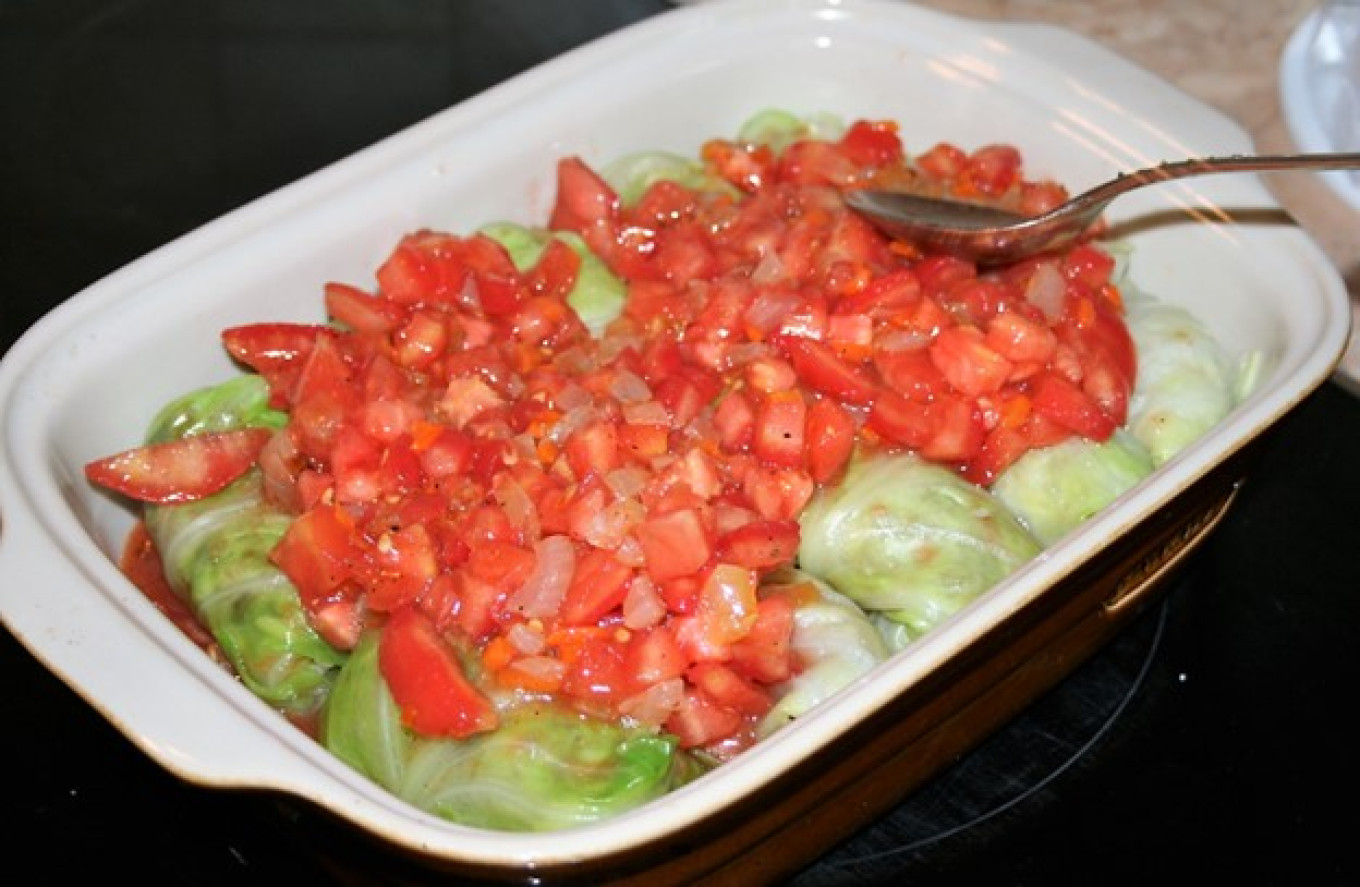A joke in Russian goes like this: some people eat meat, some people eat cabbage, but on average people eat cabbage rolls.
Today everyone in Russia knows what cabbage rolls are. But 200 years ago this was a culinary novelty for Russians.
The traditional territory of cabbage rolls is Eastern Europe and Scandinavia — although we shouldn’t forget that Asian cuisines have the almost the exact same dish.
In Russia, cabbage rolls are called “little pigeons.” In different culinary traditions they have different names and are made different ways.
Jewish holishkes are made with a mix of meat and rice, or a sweet version with rice, dried fruit and lemon peel. The meat holishkes are baked in a tomato sauce.
In Chechia and Slovakia they are called hulubky.
Serbs and Croats call them sarma.
In Bulgaria cabbage rolls are called zelevi sarmi. Bulgarians say that they appeared through the influence of Greek and Turkish cuisines. They are traditionally made with a mixture of pork and veal — and always with a great deal of paprika. They are served with yogurt and mint.
Romanian cabbage rolls are called sarmale. They are made with minced pork and dill and placed on a bed of sauerkraut. Bacon is laid on top of the sarmale and then it all goes into the oven.
Ukrainian cabbage rolls are probably the most varied. The filling can be made of pork and/or beef, with garlic, parsley, rice, sweet peppers and even millet.
In Lithuania cabbage rolls are the little doves — balandeliai. The minced meat filling might include rice, mushrooms, eggs, onions and scallions, and even sweet peppers or barley.
In Poland they are called golabki. Traditionally the minced meat is wrapped in leaves of soured cabbage. The filling is a mixture of potatoes and buckwheat groats or a mixture of minced meat and rice.
And in Russia? The basic recipe is pretty much the same all around the country: minced meat and rice are wrapped in a cabbage leaf and then baked. But when did this dish appear on Russian tables?
There are no specific references to cabbage rolls in Russian cookery until the beginning of the 19th century. Vasily Levshin’s famous “Dictionary of Cookery” published in 1796 has no mention of it. “Russian Cookery” by the same author published in 1816 does not mention cabbage rolls either.

There was, however, a similar dish: stuffed head of cabbage. Here is a 1791 recipe from Nikolai Yatsenkov, author of one of the first Russian cookbooks. The principle is different: the filling is not wrapped in individual cabbage leaves, but the entire head of cabbage is stuffed by separating the leaves and filling the space between them. To keep the stuffed head of cabbage from falling apart, it is tied with string before being boiled:
Take a head of cabbage, boil it, and then stuff it with the following: take veal, salt pork, mushrooms, parsley, onion and chop it all finely. Add salt, pepper and crustless white bread, two eggs and three yolks. Mix together the stuffing and pack it in between the leaves of the head of cabbage. Tie it up with string, boil, and serve hot.
Perhaps the secret of when and how cabbage rolls appeared in Russia might be found in works by Yekaterina Avdeyeva, the famous cookbook writer of the mid-19th century. In her “Handbook for the Experienced Housewife,” published in St. Petersburg in 1842, there are no cabbage rolls in the main chapters. But towards the end of the book she included a chapter of “Various foreign dishes that have entered Russian cookery.” And here right away is “Little Russian” borsht, vareniki and cabbage rolls:
Take tender beef and a bit of fresh lard and dice together finely; salt, then divide the prepared meat into pieces like for meat patties. Wrap each piece in a fresh cabbage leaf, place in a pot, cover with broth, cover the pot and put on a low flame to cook. When it is completely cooked through, add a spoonful of vinegar along with flour and butter, and let it boil another half-hour.
It seems like that this dish appeared in Russia fairly recently. Stuffed cabbage might have come from any number of places and people: from southern Slavs, from Poles, for Jewish settlements and Ukrainian towns.
And because it likely came to Russia from the south, it’s no wonder that in his dictionary Vladimir Dal uses a phrase that is rather mysterious these days. He compares cabbage rolls to “galushi.” “Millet with beef wrapped in a cabbage leaf and stewed in kvass.” These are certainly not the galushi we know from the works of Nikolai Gogol, delicacies that jump into your mouth. But these are as delicious. Note that Dal states that the word comes from the Podolia guberniya, which is now Vinnitsa, Ukraine.
The Russian Academy of Sciences Dictionary of the Russian Language published in 1892 also uses this now forgotten word “galushi”: “Cabbage rolls are galushi: cabbage stuffed with millet. Lenten food. Sometimes pieces of meat wrapped in cabbage leaves.” Here it is already closer to contemporary Russian cabbage rolls.

Cabbage rolls turned out to be more delicious and much easier to make than the older version of a stuffed cabbage, and the recipe was quickly adopted in home kitchens and in restaurants. It was also popular during the Soviet period — so popular that they even produced canned cabbage rolls. Just open the can, heat and eat.
But while canned goods are convenient, nothing beats homemade cabbage rolls. Soviet home cooks mastered the task of delicately stripping cabbage leaves without tearing a single one. Rolling up the filling was a minute’s work.
The cooks who didn’t want to learn the art of stripping a head of cabbage came up with a brilliant modification of the standard recipe. Called “lazy cabbage rolls,” the dish used the same ingredients as for regular cabbage rolls but was much easier to make. The cabbage was chopped and stewed together with the meat and vegetables. The dish was structured differently but it tasted just about the same — and was simple to make.

Vegetarian Cabbage Rolls
Since we are always trying to lighten up older recipes, here are vegetarian cabbage rolls. You can make them in any season, but they are, of course, most delicious with young cabbage.
Ingredients
For one head of cabbage you need
- 200 g (7 oz or 1 ½ c) mushrooms
- 3 medium onions
- 3 medium carrots
- 500 g (generous 1 lb) tomatoes
- 100 g (3.5 oz or ½ c) rice
- 50 ml (3 Tbsp) vegetable oil
- Dill, salt, pepper

Instructions
- Parboil the rice in salted water and strain in a colander.
- Carefully remove the leaves from the cabbage. Pound out the thick rib with a knife handle and cut off the very thick pieces.
- Put the leaves in a large pot, cover with hot water, salt and boil for 6-8 minutes. Pour out the water and let the leaves cool.
- Julienne the carrots, cut the onion into half rings and sauté both in vegetable oil until golden. Put half the vegetables in another container.
- Prepare the filling: slice the mushrooms and place in the pan with the onions and carrots. Sauté all together for 10 minutes.
- Preheat the oven to 190˚C (375˚F).
- Add the rice to the pan with the carrots, onions and mushrooms; stir. Salt and pepper to taste. Remove from the heat and cool.
- Scald the tomatoes with boiling water and peel them. Cut into small cubes.
- Prepare the sauce. Add the diced tomatoes to the bowl with the carrots and onions. Salt and pepper to taste.
- Cover the bottom of a baking dish with a layer of sauce.
- Make the cabbage rolls: Put 2-3 spoons of filling on each cabbage leaf, wrap like an envelope — first fold the sides over the filling and then roll up. Place them in the baking dish. When they are all in the dish, pour the rest of the sauce on top.
- Cover with foil and bake in the oven for 1 hour.






